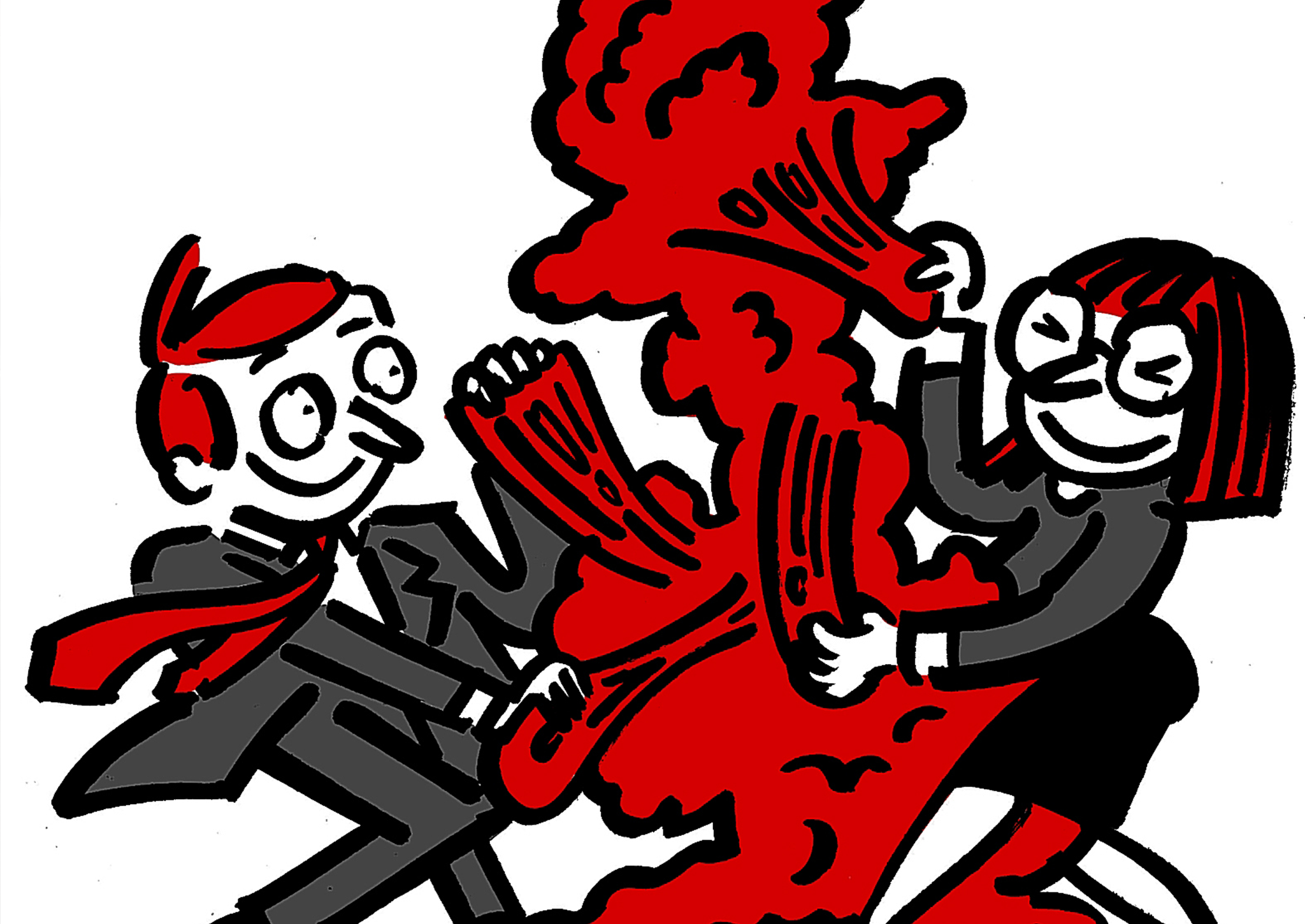The UK was formed in nationalist fires, and today is no different
In future histories of this election, the two-faced front pages of The Sun will occupy a special place


A grand old edifice is going up in smoke. Sudden catastrophe has gutted the interior arrangements of a much-loved stately home, packed with precious heirlooms, which has stood proudly since the early 18th century.
Yes, the United Kingdom has suffered grave internal damage since the rise of the Scottish National Party lit a fire in its attic. But just like Clandon Park house – the National Trust-owned mansion in Surrey reduced to a shell after a conflagration on Wednesday – it will survive and open for business again. Deal or no deal, in the aftermath of the election, the Scottish Question may force the entire political estate of Britain, and its Ulster annex, to bring in the parapet-to-cellar renovation team.
On one side of the ideological border, a Westminster regime of any colour facing down a bloc of 50-plus separatists feels like Armageddon; on the other, an injection of fresh blood into a moribund body politic. Look, however, at the heirs in wealth and sway to the Hanoverian grandees who built their Palladian palace at Clandon, and a less apocalyptic scene comes into view.
Whether, by 2025, Scotland enjoys formal sovereignty or near-total autonomy within a federalised UK, change will come. Eight centuries of experience since Magna Carta suggests that the hybrid, fluid elites of these offshore islands will evolve in order to exploit it, just as they have in the face of every past upheaval.
In future histories of this election, the two-faced front pages of The Sun this Thursday – cheering Cameron, the Tories and the Union in England and Wales, hailing Sturgeon and the SNP in Scotland – will occupy a special place. Their proprietor Rupert Murdoch may feel a twinge of ancestral sentiment in favour of the nationalist cause. Still, the double emissions of his organs did present a textbook example of the sheer flexibility of corporate power in an age when the mighty extraterritorial firm can dictate terms to the puny geographical state.
We don’t, though, need to travel as far as Murdoch in his New York lair for evidence of the sheer elasticity of a local or imported ruling class. Back at Clandon Park – and let’s hope that reconstruction work gets going fast – the barons and then Earls of Onslow wrote their own story of adapt-and-survive. The family filled high offices of state, serving in the Conservative interest after the development of modern party politics. As MP for nearby Woking, Cranley Onslow – not an heir to the main branch, but a scion of the clan – first served as a minister under Margaret Thatcher. Later, as chairman of the backbench 1922 Committee, he helped to force her out in 1990, and to secure the succession of John Major. Meanwhile, the libertarian, anti-racist seventh Earl of Onslow became the first hereditary peer to star on the BBC’s Have I Got News for You.
Students of the British oligarchies would be hard pressed to believe that the decorative flummery of a Scottish state or quasi-state will by itself make them quake in boots hand crafted at John Lobb of St James’s. We have become familiar with the idea of an “establishment”, or whichever proxy term you may prefer, that restores its flagging vigour through the porous membrane of marital, political or business partnerships. From the relatively “open elite” of Tudor times to the 5,000 American heiresses who rescued the aristocracy from ruin and the latest Sunday Times Rich List (55 of our 117 resident billionaires are foreign born), the topmost layer of the super-class must admit nutrients from below and from beyond. Even a writer as keen as Owen Jones to portray a toxic monolith of power does accept – in his bestseller The Establishment – that “the upper crust in British society has always been in a state of perpetual flux”.
The renewed prospect of an end to the Union of 1707 – either de jure or de facto – ought to modify this picture. It’s not simply that those who govern, employ, service, entertain and inform (or misinform) us reproduce themselves by readjustment and reform. As Tancredi insists to the Prince of Salina in Lampedusa’s masterpiece The Leopard, “If we want things to stay as they are, things will have to change.”
The territory itself and its political geography have often undergone deep shifts as well. Owen Jones’s upper crust in flux – the molten lava of authority – from time to time congeals to leave an altered landscape on the map as well as in City banks or on Westminster benches. Look more closely, and the mystic union that in the speeches of alarmist Tories has endured for 300 tranquil years is nothing of the sort. Since 1707, let alone 1603, the state entities within the British Isles have proved as pliable as plasticine.
A few weeks ago, I visited for the first time the grounds of Stormont Castle in Belfast – that curious outstation of the UK state whose problematic existence bears witness to the botched and makeshift nature of our polity. Towering over parkland around the Assembly building stands a giant statue of Edward Carson, the Tory Unionist who fashioned at gunpoint the statelet of Northern Ireland via the armed revolt of the Ulster Volunteers in 1914.
Carson loved the original United Kingdom of 1801 so much that he broke it up by inciting violent mutiny against the Home Rule Bill. Once the Ulstermen had risen in the North, the Republicans of the Irish Volunteers duly followed suit in Dublin at Easter 1916. Imperial Germany armed both sides. Much earlier, in 1895, Carson had as opposing counsel destroyed his old friend and classmate from Trinity College, Dublin, in the dock. But then as Oscar Wilde wrote in Reading Gaol – to which Carson’s advocacy helped to despatch him – “all men kill the thing they love”.
Carson killed his United Kingdom. Yet it healed its ragged Irish stump and, after the treaty of 1921, smoothly came to terms with a state in the South. Mass migration to England and Scotland – sometimes temporary, often permanent – has never ceased. Long before EU accession, Irish citizens enjoyed strictly illogical privileges within the UK – and vice versa. When the Troubles erupted in the North after 1969, they owed their virulence not so much to any pressure from the quiet Republic as to the refusal of Carson’s Orange-dominated province to integrate its Catholic population. Blame him for that as well.
Even prior to Carson’s coup, internal tensions had pulled the Union into strange shapes. The constitutional expert Vernon Bogdanor notes that, for 30 years up to 1914 and the thwarting of Home Rule, Liberal governments had depended for a majority on the nationalists of Parnell and Redmond’s Irish parliamentary party. Through the pomp and pageantry of the late-Victorian decades, across the long Edwardian summer, imperial Britain often owed its administration to a phalanx of MPs who either took a semi-detached view of the UK state, or had no faith in it at all. During that time, the “Conservative and Unionist Party” acquired the name that it still bears only because a large number of members on the opposing benches, and their electors, devoutly wished to wreck that unity.
Bogdanor thinks that, 800 years after Magna Carta, a severely gridlocked outcome of next week’s polls will drag the UK – England as much as Scotland – towards “a genuine constitutional moment”. Any fresh settlement, he argued in a New Statesman essay, should lead not only to voting reform and an end to the imbalances of first past the post, but “publicly stated constitutional rules” drawn up at a UK-wide convention. Out with muddle and fudge; in with the cold light of “openness and transparency”. Yet in our playdough union – which, as Ireland shows, can shed a large chunk of its terrain without most citizens caring very much – muddle and fudge have served the labile elites quite well.
Since Irish partition, wartime alliances, Nato adherence and the EU have come along to confirm that pooled or mixed sovereignty alone does little to upset the powers that be. Should the post-2015 UK embrace full-blown federalism or else a three-states-in-two islands model, the result will in any case look lopsided and irregular. But then lopsidedness and irregularity have long been hallmarks of the multinational, dual-island terrain. In these kingdoms of make do and mend, each panicky retrofit rapidly acquires the aura of a hallowed ancient tradition.
In his bracing new book Magna Carta: the True Story Behind the Charter, historian David Starkey remarks that the stages of the conflict between King John and the rebel nobles – from bitter showdown to renewed legitimacy – set a precedent for later movements of reform. As the Runnymede charter bedded down in law, so “the clothes of the radicals would, after much chewing of fat and occasional spilling of blood, be stolen by the conservatives and, after a modest amount of re-tailoring, be found to fit perfectly”. In today’s semi-incinerated UK, the state’s scorched interior cries out for top-to-bottom repair. And in one style or another – Nordic modernist or Romantic baronial – full Scottish self-determination may roll up to the front door soon.
Should it arrive, listen out for the delighted approval of today’s diehard unionists as they say: “Really, it’s just what we always wanted.”

Join our commenting forum
Join thought-provoking conversations, follow other Independent readers and see their replies